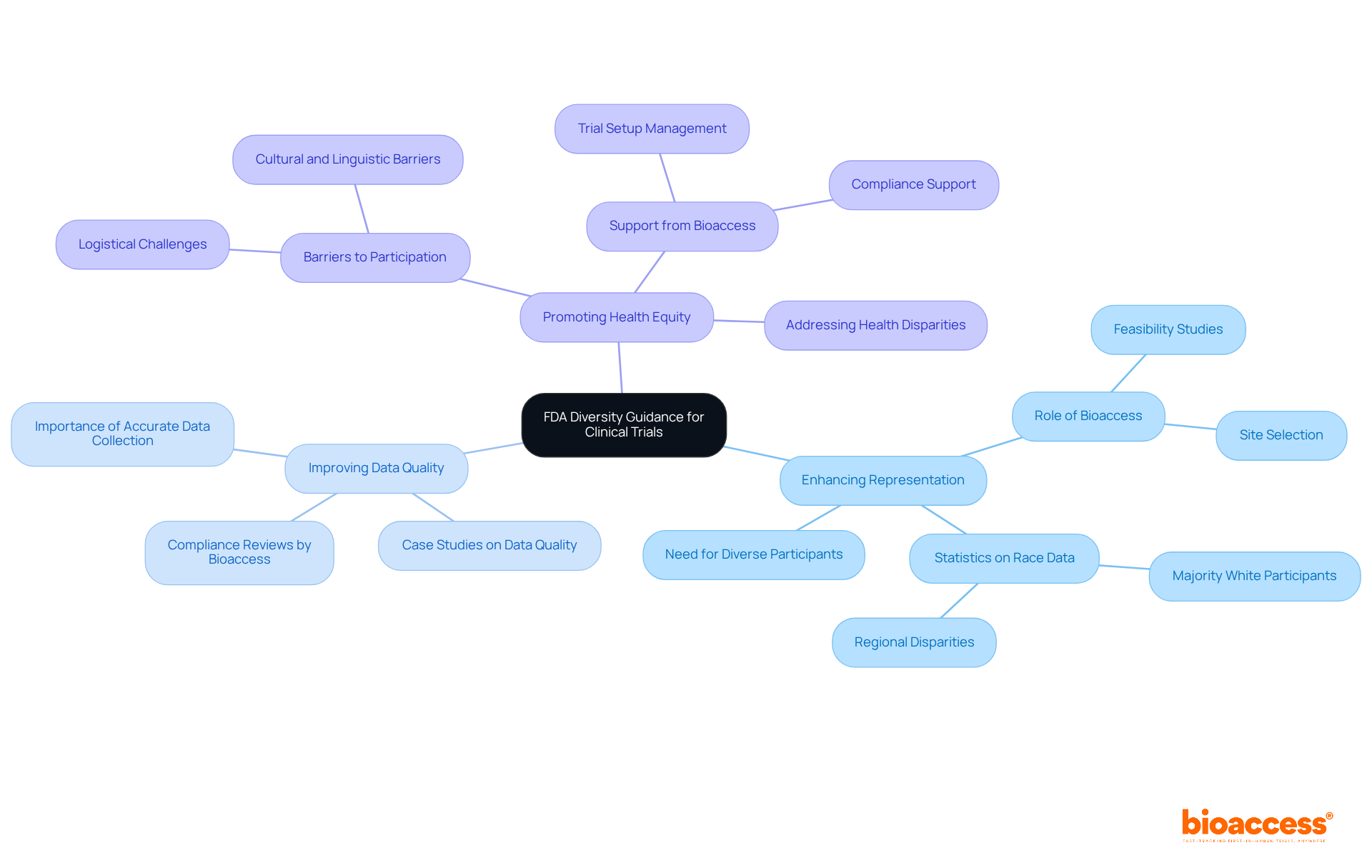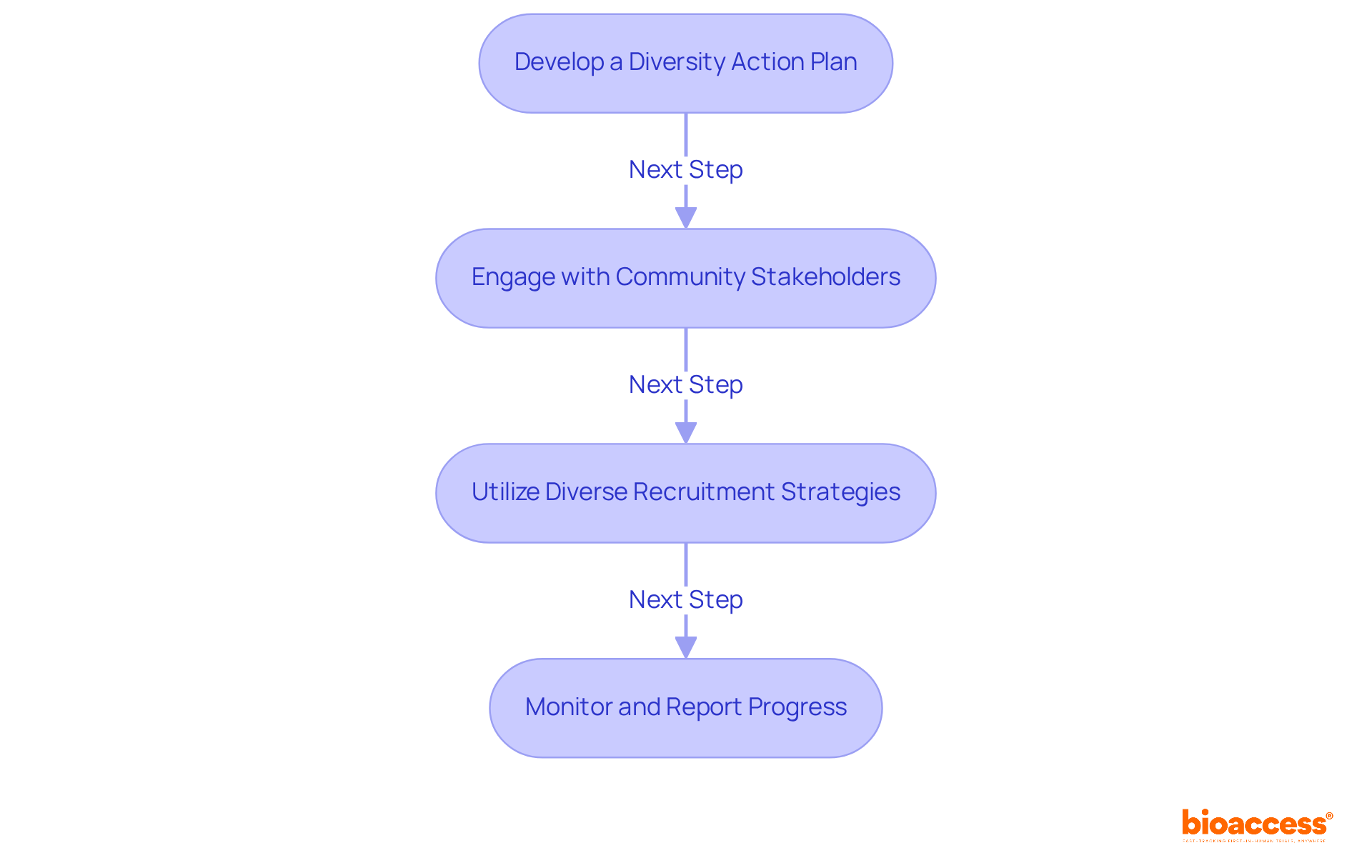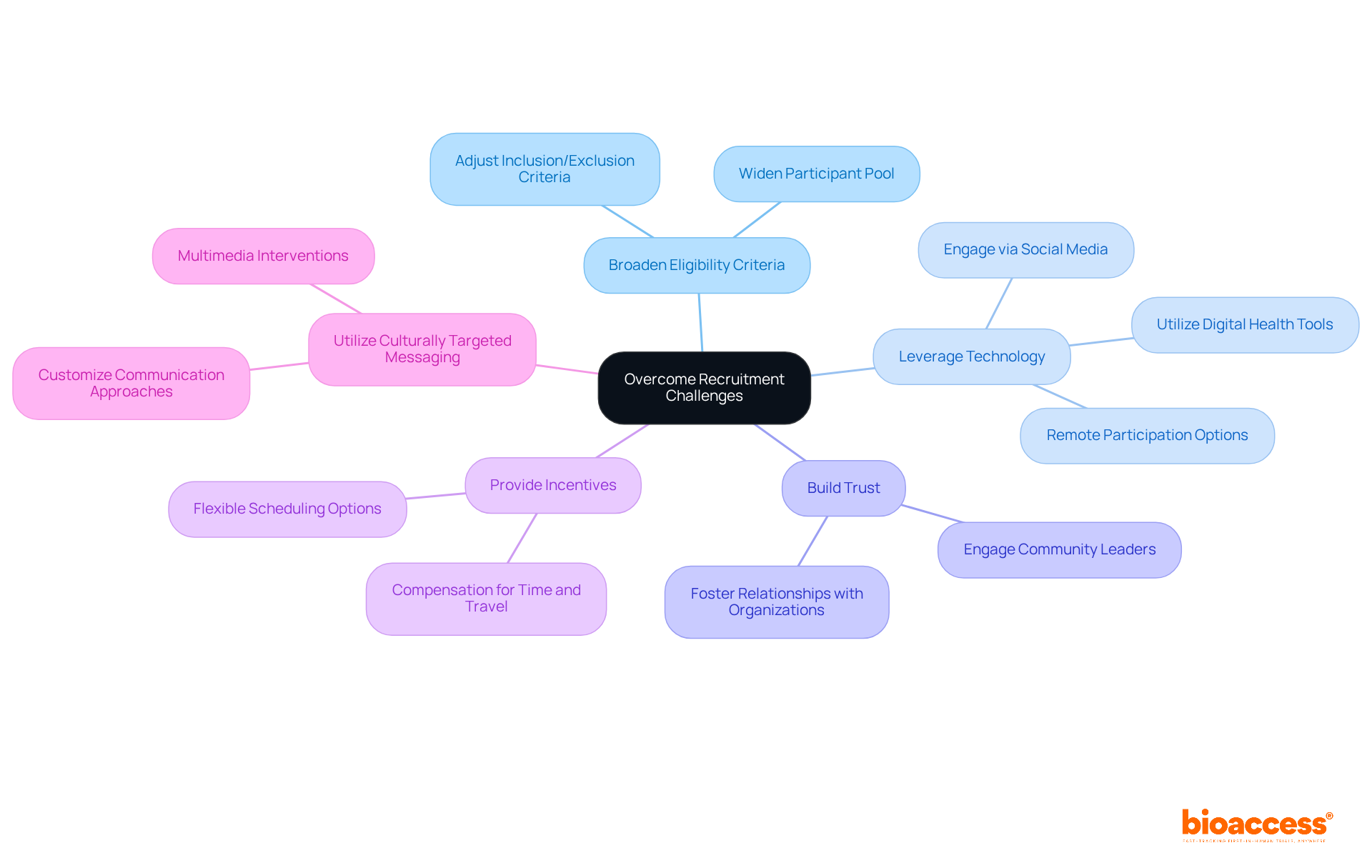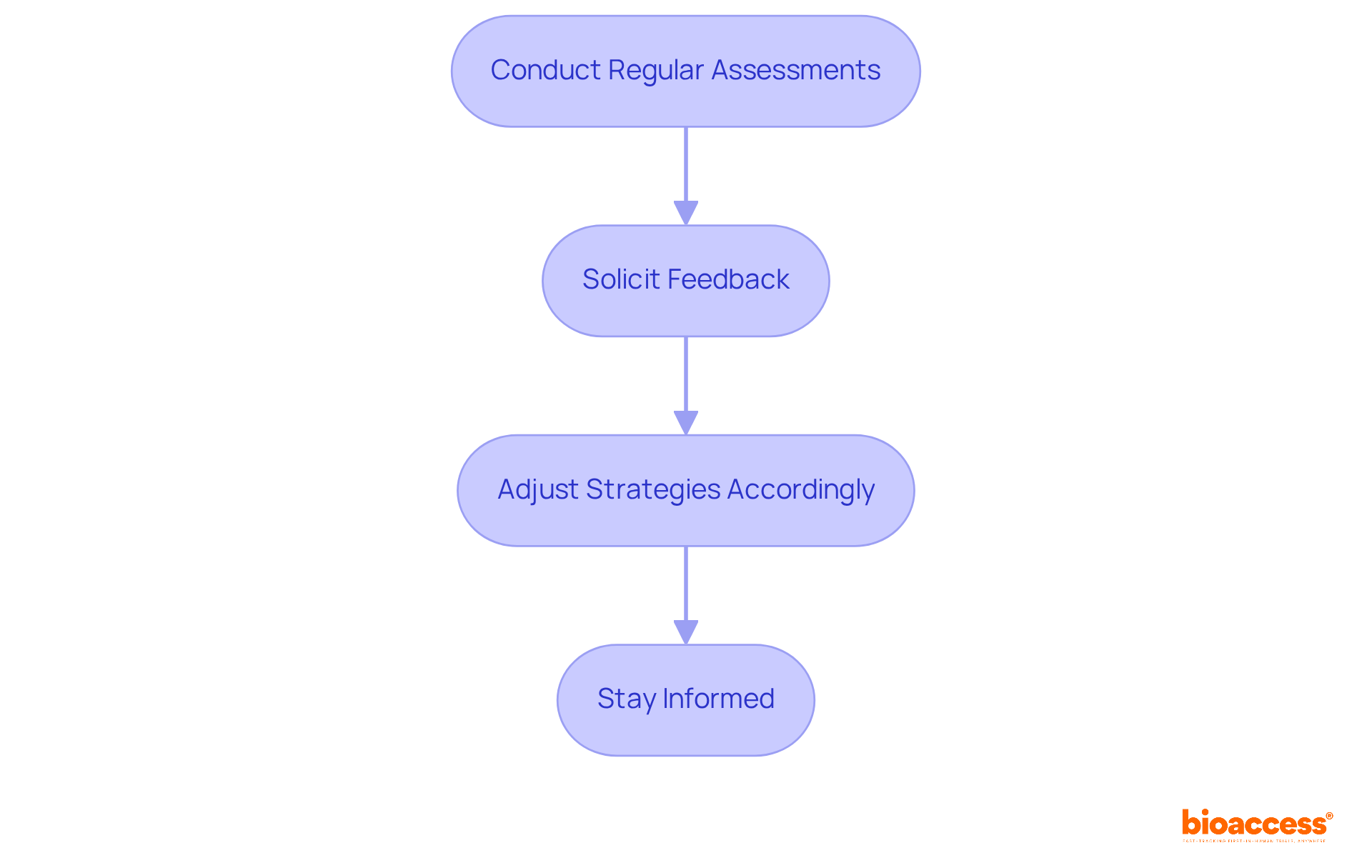


The article addresses the critical need to master the FDA's diversity guidance in clinical trials, outlining essential steps and strategies for enhancing participant representation. It underscores the necessity of developing a Diversity Action Plan, engaging community stakeholders, and employing diverse recruitment strategies. These measures are vital to ensure clinical trials are inclusive and yield reliable data that accurately reflects the demographics of the population. Ultimately, this approach promotes health equity, which is paramount in advancing clinical research.
The FDA's diversity guidance for clinical trials emphasizes a critical need for inclusivity in medical research. It underscores the significance of representing underrepresented groups to guarantee that health products are effective for all. This article explores the essential steps and strategies that sponsors can implement to align their clinical trials with these guidelines, ultimately enhancing data quality and promoting health equity. However, as the landscape of clinical research evolves, how can sponsors effectively navigate the complexities of diverse participant recruitment while overcoming inherent challenges?
The critical necessity of incorporating underrepresented groups in clinical studies is emphasized by the FDA diversity guidance clinical trials, ensuring that medical products are safe and effective for all demographic segments. The key objectives outlined in this guidance include the following:
These objectives are crucial for sponsors as they develop their Diversity Action Plans (DAPs) and implement strategies in accordance with the FDA diversity guidance clinical trials. Expert opinions, such as those from FDA Commissioner Robert M. Califf, emphasize that adherence to these guidelines can significantly enhance the credibility of clinical research, ultimately benefiting public health.

To implement the FDA's diversity guidance effectively, sponsors should consider the following practical steps:
Develop a Diversity Action Plan (DAP): Create a detailed DAP that outlines specific goals for participant enrollment, including demographic breakdowns by race, ethnicity, age, and sex. Utilizing bioaccess's expertise in overseeing Early-Feasibility Studies, First-In-Human Studies, Pilot Studies, and Post-Market Clinical Follow-Up Studies can assist in ensuring these objectives are achieved through customized approaches.
Engage with Community Stakeholders: Work together with community organizations and advocacy groups to establish trust and enable outreach to marginalized groups. Bioaccess can assist in identifying and connecting with these stakeholders to enhance recruitment efforts.
Utilize Diverse Recruitment Strategies: Employ various recruitment methods, such as digital marketing, community events, and partnerships with local healthcare providers, to reach a broader audience. With bioaccess's experience in conducting diverse studies, sponsors can implement effective recruitment approaches that adhere to the FDA diversity guidance clinical trials for various populations.
Monitor and Report Progress: Regularly evaluate enrollment data against DAP objectives and modify approaches as necessary to guarantee ongoing enhancement in diversity initiatives. Bioaccess's comprehensive project management services can provide the necessary oversight and reporting to track progress effectively.

To effectively address recruitment challenges and enhance diversity in clinical trials, consider implementing the following strategies:
Broaden Eligibility Criteria: Adjusting inclusion and exclusion criteria can significantly widen the pool of potential participants. This flexibility allows for greater representation of diverse populations, ensuring that clinical trials reflect the demographics of the broader community.
Leverage Technology: Utilizing digital health tools and social media platforms can enhance outreach efforts, particularly among younger demographics who are more likely to engage online. For example, almost 60% of possible attendees reside over two hours away from a study center, making remote involvement essential for boosting engagement.
Build Trust: Establishing strong relationships with community leaders and organizations is essential for fostering trust. Engaging with these stakeholders can encourage participation from underrepresented groups, addressing historical mistrust that often hinders enrollment.
Provide Incentives: Offering compensation for time and travel, along with flexible scheduling options, can help reduce barriers to participation. This approach recognizes the logistical difficulties many possible attendees encounter, especially those from varied backgrounds.
Utilize Culturally Targeted Messaging: Customizing communication approaches to connect with specific communities can enhance engagement. Research indicates that culturally targeted multimedia interventions can significantly increase willingness to participate, as seen in studies where enrollment likelihood rose from 45.9% to 79.6% through tailored outreach.
By applying these approaches, clinical trial sponsors can enhance enrollment diversity in line with FDA diversity guidance clinical trials, ultimately resulting in more fair healthcare outcomes and improved research validity.

Conduct Regular Assessments: It is imperative to frequently assess hiring approaches and demographic data to identify areas that require enhancement. This ongoing examination is crucial for understanding the impact of diversity initiatives and ensuring they effectively address the needs of marginalized groups. For instance, while racial and ethnic minorities make up 39% of the U.S. population, they represent only 2% to 16% of clinical study subjects, underscoring the necessity for effective strategies.
Solicit Feedback: Actively gathering input from contributors and community partners is essential for gaining insights into their experiences and perspectives regarding the process. This feedback is invaluable for pinpointing barriers to participation and improving the overall trial experience. Engaging with patient advocates early in the study design process can yield critical insights into the needs and motivations of diverse patient communities.
Adjust Strategies Accordingly: It is vital to utilize assessment data and feedback from participants to refine recruitment strategies. This iterative process ensures that approaches remain aligned with the objectives of the Diversity Action Plan (DAP) and effectively tackle the unique challenges faced by diverse populations. A notable example is the Barbershop-Based Blood Pressure Control Trial, which successfully recruited over 300 participants by leveraging community trust.
Stay Informed: Continuously monitoring changes in FDA diversity guidance clinical trials and industry best practices is essential for enhancing diversity efforts while ensuring compliance with regulatory requirements. As George A. Mensah articulated, inclusion in clinical research serves as a crucial method for addressing health disparities, highlighting the need for ongoing adaptation.

Incorporating the FDA's diversity guidance into clinical trials is not merely a regulatory requirement; it is a vital step toward ensuring that medical products are safe and effective for all demographic groups. By enhancing representation, improving data quality, and promoting health equity, the guidance provides a framework that sponsors can utilize to create more inclusive and relevant clinical research. This commitment to diversity is essential for achieving credible results that reflect the needs of the entire population.
The article outlines practical strategies for implementing this guidance effectively. Key steps include:
Each of these strategies plays a crucial role in overcoming the barriers that have historically limited participation from underrepresented groups. The importance of building trust and employing culturally targeted messaging cannot be overstated, as these approaches foster a more inclusive environment for clinical trials.
Ultimately, the significance of the FDA diversity guidance extends beyond compliance; it is a call to action for the entire clinical research community. By prioritizing diversity and actively working to include marginalized populations, stakeholders can help address health disparities and improve health outcomes for all. Embracing these practices not only enhances the validity of research but also paves the way for a more equitable healthcare system. The time to act is now—implementing these strategies can transform clinical trials into a true reflection of the diverse society they aim to serve.
What is the main purpose of the FDA diversity guidance for clinical trials?
The main purpose of the FDA diversity guidance is to ensure that underrepresented groups are incorporated into clinical studies, making medical products safe and effective for all demographic segments.
What are the key objectives of the FDA diversity guidance?
The key objectives include enhancing representation in clinical trials, improving data quality, and promoting health equity among diverse populations.
Why is enhancing representation in clinical trials important?
Enhancing representation is important because clinical trial participants must reflect the diversity of the population that will use the medical products, ensuring that results are relevant across various demographic groups.
What issue was highlighted regarding the racial diversity of clinical trial participants in 2022?
In 2022, the majority of study participants in clinical research reporting race data were white, indicating an urgent need for more inclusive practices.
How does the FDA diversity guidance improve data quality?
The guidance improves data quality by ensuring accurate data collection that reflects diverse demographic groups, which increases the reliability of study results and is crucial for regulatory approval and market success.
What role does bioaccess play in supporting the objectives of the FDA diversity guidance?
Bioaccess supports these objectives through services such as feasibility studies, site selection, compliance reviews, and project management, which help identify and engage diverse groups in clinical trials.
How does the FDA aim to promote health equity through its diversity guidance?
The FDA aims to promote health equity by addressing health disparities through the inclusion of diverse populations in research, leading to improved health outcomes and a better understanding of treatment responses across different demographics.
What barriers often hinder the participation of underrepresented groups in clinical studies?
Logistical and financial barriers, along with cultural and linguistic challenges, often hinder the participation of underrepresented groups in clinical studies.
What is the significance of adhering to the FDA diversity guidance for sponsors?
Adhering to the FDA diversity guidance is significant for sponsors as it enhances the credibility of clinical research and ultimately benefits public health.